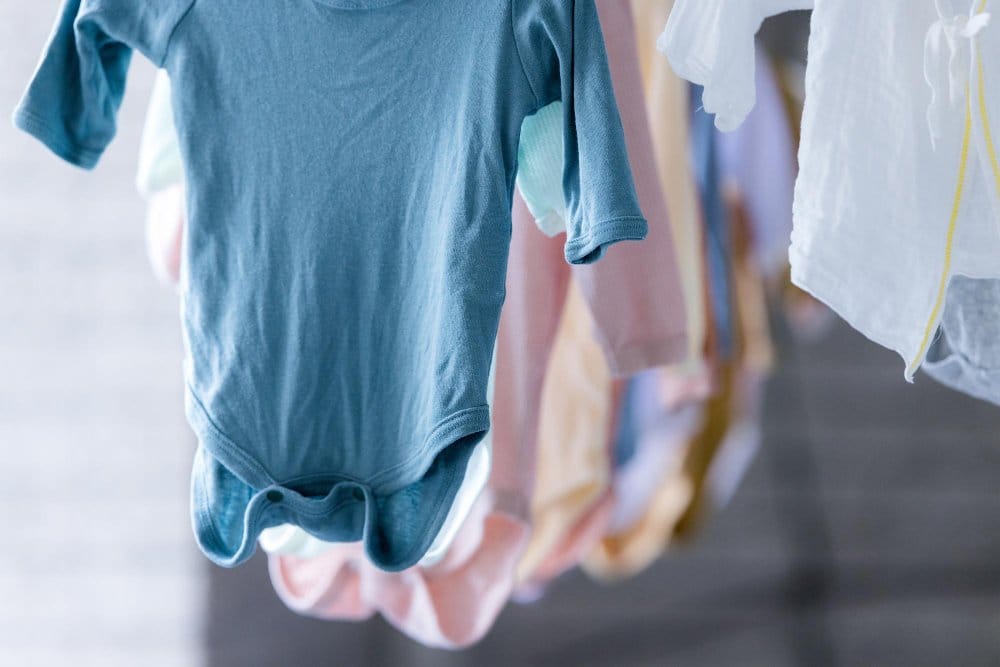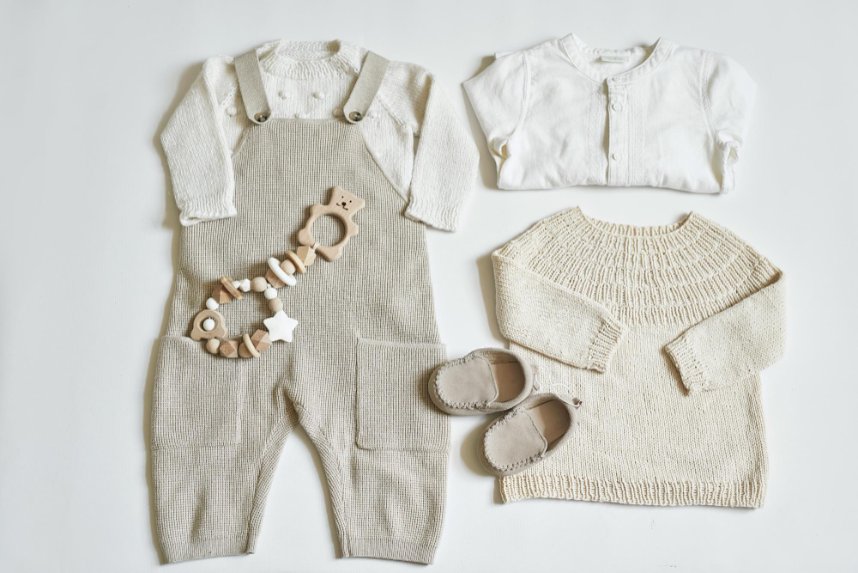Your complete 2025 guide to preventing baby clothing shrinkage and maintaining perfect fit
Table of Contents
- Introduction
- Why Baby Clothes Shrink
- Common Fabrics Used in Baby Clothes
- The Role of Washing and Drying Methods
- Preventing Shrinkage in Baby Clothes
- Seasonal Care Considerations
- Organic & Sustainable Baby Clothing Care
- Smart Sizing and Brand Comparisons
- Troubleshooting Common Problems
- Special Methods for Minimizing and Reversing Shrinkage
- What To Do If Baby Clothes No Longer Fit
- Safety Considerations and Medical Advice
- Frequently Asked Questions
- Conclusion
It can be surprising the first time you take baby clothes out of the dryer and notice they’ve shrunk. Most baby clothes do shrink a little bit, especially if they’re made of cotton or other natural fibers. This can happen during the first wash and dry, even if you follow the care label instructions perfectly.
Quick Facts About Baby Clothing Shrinkage
- Cotton baby clothes can shrink 5-10% after first wash
- Polyester blends typically shrink only 2-3%
- Heat is the primary cause of shrinkage
- Most shrinkage occurs in the first wash cycle
- Pre-shrunk doesn’t mean no shrinkage
💡 Want to predict shrinkage for your specific clothes?
Try our Baby Clothes Shrinkage Calculator for personalized results!
The right washing and drying methods can make a big difference when it comes to shrinking. You want to be careful with heat and follow best practices to keep your baby’s clothes looking and fitting their best. Learning more about fabric types and care instructions will help you feel more confident about laundry day.
Why Baby Clothes Shrink
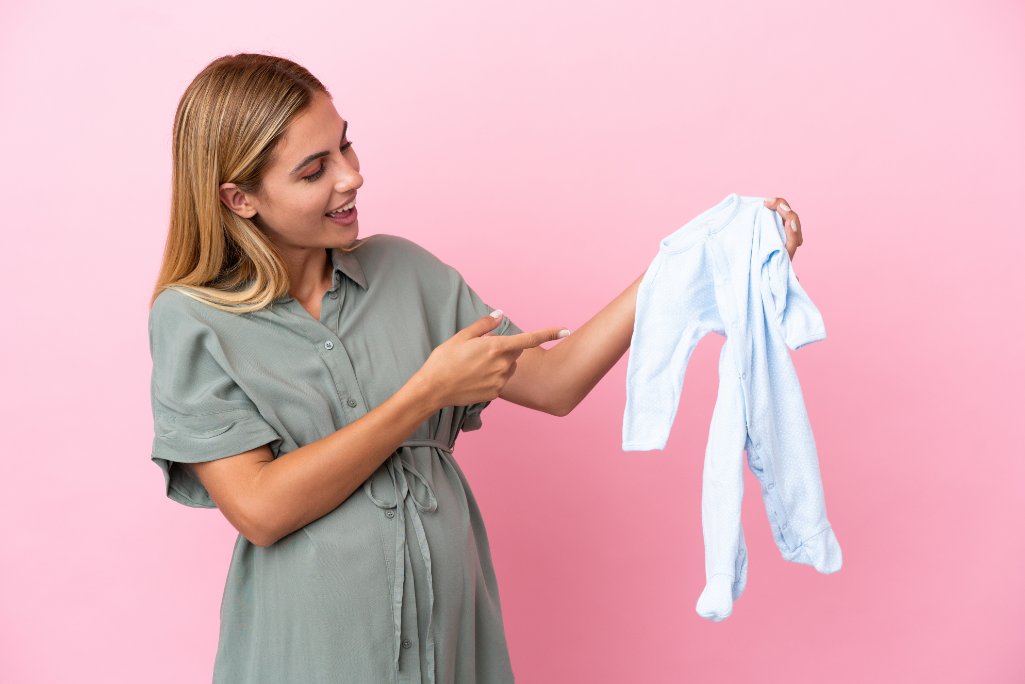
Baby clothes often shrink due to what they are made of and how the fabrics react to washing and drying. Understanding the reasons behind shrinkage can help you care for baby clothes better and avoid surprises after laundry.
Fiber Types and Shrinkage
Most baby clothes are made from different fibers like cotton, polyester, wool, nylon, rayon, linen, or denim. Cotton is the most common because it is soft and gentle on skin. Pure cotton is more likely to shrink than synthetic fibers like polyester or nylon. Polyester, rayon, and nylon tend to hold their shape after washing, and mixtures of cotton with synthetic fibers can shrink less.
| Fiber | Shrinkage Risk | Care Difficulty | Notes |
|---|---|---|---|
| 100% Cotton | High (5-10%) | Medium | Shrinks most when washed/dried hot |
| Cotton Blends | Medium (2-5%) | Low | More forgiving than pure cotton |
| Organic Cotton | High (5-8%) | Medium | May shrink more due to minimal processing |
| Wool | Very High | High | Prone to felting and major shrinkage |
| Polyester | Low (0-2%) | Low | Keeps shape well, heat resistant |
| Bamboo | Medium (3-6%) | Medium | Eco-friendly but can shrink |
| Rayon | Medium (3-5%) | Medium | Can shrink if not treated properly |
Is it normal for baby clothes to shrink?
Yes, it’s completely normal for baby clothes to shrink, especially during the first wash. Most natural fiber clothing experiences some shrinkage when exposed to heat and moisture. The key is understanding how much shrinkage to expect and planning accordingly.
How Fabrics React to Washing and Drying
Washing and drying methods can change the size and shape of baby clothes significantly. Hot water and high heat in the dryer make fabrics tighten, causing shrinkage. Cotton and wool react the most since their fibers are more sensitive to heat and moisture. Even cool water can cause some shrinkage during the first wash because fibers relax and return to their natural state after being stretched or processed during manufacturing.
How Shrinkage Happens
Air drying or washing in cold water can help limit shrinking. Using gentle cycles and avoiding overcrowding the washer also helps protect the fibers. Some clothes have care labels with instructions on how to wash and dry to reduce shrinkage. You should always check these before washing new baby clothes.
Why New Clothes Shrink So Much
New clothes often shrink more dramatically than expected because manufacturers stretch fibers during production to create specific sizes. When these stretched fibers encounter heat and moisture for the first time, they contract back to their natural dimensions. This is why washing clothes before first use is so important.
Common Fabrics Used in Baby Clothes
Fabric choice affects how baby clothes feel, wash, and fit over time. Each type of material acts differently when it comes to comfort, stretching, and shrinking in the laundry.
100% Cotton and Cotton Blends
Most baby clothes use 100% cotton or cotton blends because these are soft and gentle on the skin. Cotton breathes well, which helps keep babies cool. Still, cotton fabrics almost always shrink when washed and dried, especially the first time. Shrinkage can be more noticeable with 100% cotton than with blends.
Cotton blends, which might mix in polyester or rayon, shrink less and can be more durable. Some manufacturers pre-shrink cotton baby clothes, but not all do, so you should always read labels before washing. Pure cotton is easy to stain, but it is simple to clean with proper techniques.
Will baby clothes shrink in hot water?
Yes, baby clothes will definitely shrink more in hot water. Hot water causes cotton fibers to contract significantly. Always use cold water (30°C/86°F or below) for baby clothes unless treating specific stains that require warmer temperatures.
Polyester and Synthetic Materials
Polyester, nylon, and rayon are also found in baby clothing. Polyester resists shrinking and wrinkles better than cotton. It’s strong, stretches well, and dries quickly. You can wash polyester clothes without worrying much about shrinking or warping.
These materials can sometimes feel less soft than pure cotton. However, blends using both polyester and cotton balance softness with less shrinkage. Nylon and rayon add stretch and strength, but rayon can be delicate and might pill after many washes.
Wool and Specialty Fabrics
Wool is not as common for everyday baby clothes, but it is used for warm hats, sweaters, and blankets. Wool insulates well, even when it gets damp. However, it often shrinks dramatically if washed the wrong way, so you should always use cold water and air dry wool items.
Other special fabrics like linen and denim can appear in baby clothing. Linen is cool and breathable but tends to wrinkle and sometimes shrinks like cotton. Denim is sturdy, though stiff, and usually found in overalls or jackets for older babies.
The Role of Washing and Drying Methods

How you wash and dry baby clothes has a big effect on whether they shrink. The temperature of the water, wash cycle settings, and drying method all play important roles.
Should you wash baby clothes at 30 or 40?
For preventing shrinkage, 30°C (86°F) is better than 40°C (104°F). However, the choice depends on your priorities:
What happens if I wash at 40 instead of 30?
Washing at 40°C instead of 30°C increases shrinkage risk by about 2-3% for cotton items. You’ll get better stain removal but may notice tighter fits after washing. For everyday baby clothes, 30°C is usually sufficient.
Washing With Cold Water Versus Hot Water
Using hot water is one of the main reasons baby clothes shrink. Hot water causes natural fibers, like cotton, to contract. This leads to clothes getting smaller after each wash.
Cold water is much gentler on fabric. When you use cold water, baby clothes keep their size and shape better. Cold water is also good for removing light stains while being less harsh on delicate materials.
Delicate Cycle and Temperature Control
Using the delicate cycle is another way to help prevent shrinking. The delicate setting on washing machines uses slower spin speeds and shorter wash times. This reduces stress on the fabric.
When washing, you should also avoid using harsh detergents or bleach, as these can damage the fibers and make shrinkage more likely. The delicate cycle works best with soft baby clothes and keeps them comfortable.
Will baby clothes shrink in the tumble dryer?
Yes, tumble drying is actually the biggest cause of shrinkage in baby clothes. High heat pulls moisture out of clothes quickly, but it also contracts the fibers, making the clothes tighter and shorter.
Dryer Heat Settings for Baby Clothes
- High Heat: Avoid completely – causes maximum shrinkage
- Medium Heat: Use only for thick items like towels
- Low Heat: Best for most baby clothes
- Air Dry: Safest option, no shrinkage risk
You should dry baby clothes on a low heat setting or use air dry when possible. This helps preserve the elasticity and stretch of the garments. If you must use the dryer, avoid overdrying, as leaving clothes in too long adds to potential shrinkage.
Preventing Shrinkage in Baby Clothes
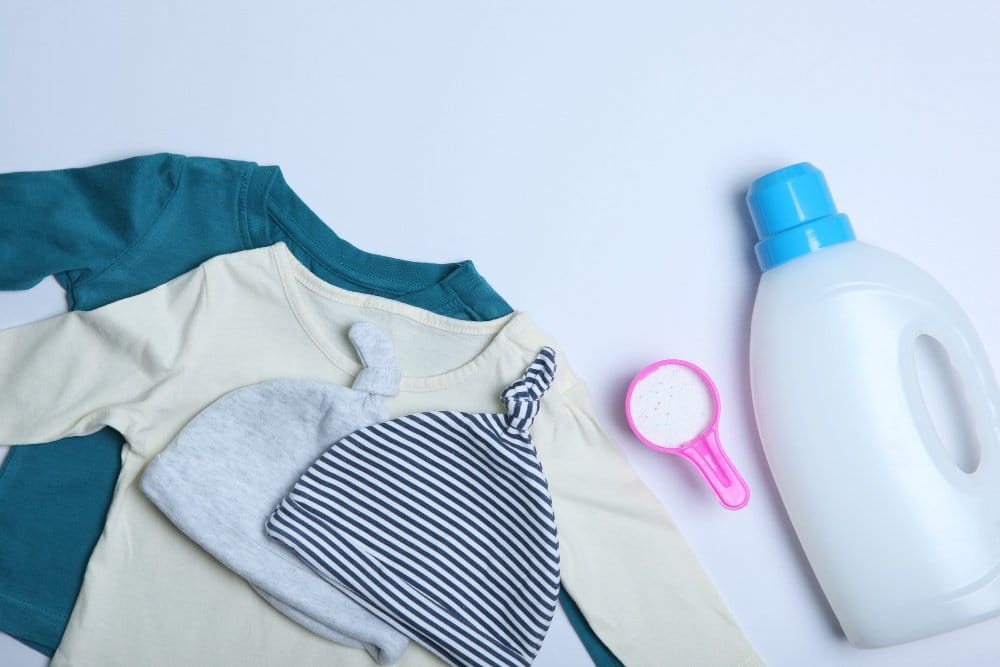
Baby clothes often get smaller after washing and drying. You can lower the chances of shrinkage with a few careful steps both before and after you purchase items for your baby.
Is it better to size up or down in baby clothes?
For shrinkage prevention, it’s almost always better to size up. Here’s why:
Sizing Strategy Based on Fabric Type
- 100% Cotton: Size up 1-2 sizes to account for 5-10% shrinkage
- Cotton Blends: Size up 1 size for 2-5% shrinkage
- Polyester/Synthetic: True to size, minimal shrinkage
- Organic Cotton: Size up 1-2 sizes, often shrinks more
- Pre-shrunk items: Size up 1 size for safety
🔢 Get precise shrinkage predictions:
Use our interactive shrinkage calculator to determine exact sizing needs for your baby’s clothes.
Proper Sizing and Choosing Pre-Shrunk Items
You should check sizing charts carefully when buying new onesies, t-shirts, or leggings. Many brands list measurements for each age or weight group, so you should always use those numbers instead of just picking by age. Sometimes clothes that are marked for “three months” run small, and starting with a slightly bigger size prevents tight fits after washing.
Some companies now offer pre-shrunk baby clothes. When you see this on a label, it means the fabric has already gone through a process to reduce shrinkage later. Cotton is the most common fabric for baby clothes, but it is also the fabric that shrinks the most if it has not been pre-shrunk.
How quickly do babies grow out of their clothes?
Newborns typically outgrow clothes every 6-8 weeks during the first 6 months. After that, growth slows to every 2-3 months. Buying slightly larger sizes helps accommodate both growth spurts and potential shrinkage.
Air Drying Versus Machine Drying
How you dry baby clothes makes the biggest difference in preventing shrinkage. Heat from a dryer is the main cause of shrinking, especially for cotton onesies and leggings. Air drying by hanging clothes on a drying rack or line helps keep their original size and shape.
| Drying Method | Shrinkage Risk | Time Required | Fabric Care |
|---|---|---|---|
| Air Dry | None | 4-12 hours | Excellent – preserves fibers |
| Low Heat Dryer | Low | 45-60 minutes | Good – minimal damage |
| Medium Heat | Medium-High | 30-45 minutes | Fair – some fiber damage |
| High Heat | Very High | 20-30 minutes | Poor – significant damage |
Do you need to wash baby clothes inside out?
Washing baby clothes inside out can help prevent shrinkage and fading, especially for:
- Items with prints or decorations
- Dark colored clothes
- Delicate fabrics like organic cotton
- Clothes with appliques or embroidery
Turning clothes inside out protects the outer surface from abrasion and helps maintain the original size by reducing stress on the visible fibers.
Seasonal Care Considerations
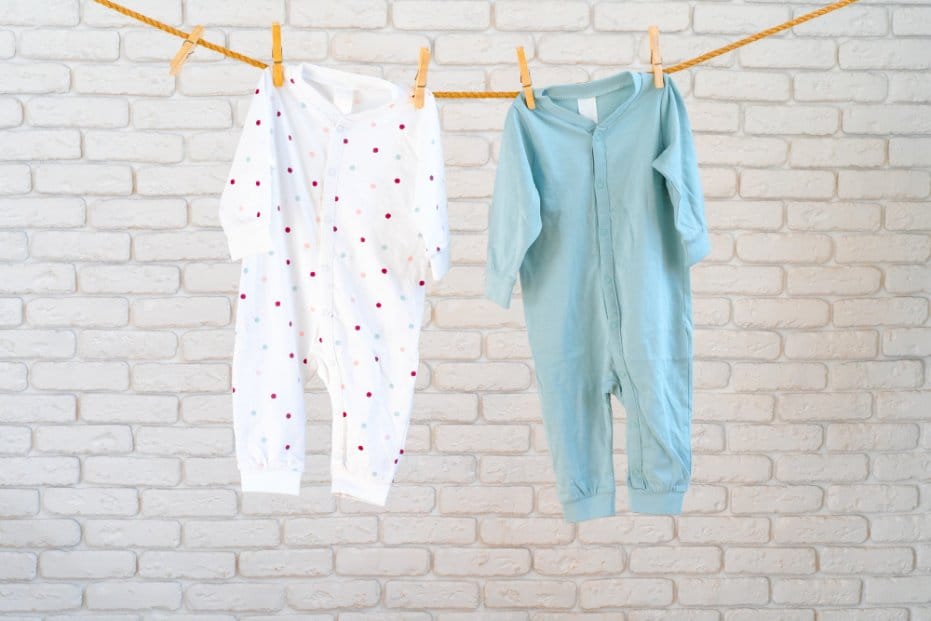
Different seasons present unique challenges for drying baby clothes and preventing shrinkage. Understanding how climate affects your laundry routine helps maintain clothing quality year-round.
Winter Drying Challenges
Problems: High indoor humidity, limited outdoor drying, longer drying times
Solutions:
- Use dehumidifiers in laundry areas
- Position drying racks near heat sources
- Ensure proper ventilation to prevent mold
- Consider sublimation drying in freezing temperatures
Summer Strategies
Benefits: Fast outdoor drying, natural UV sanitization
Precautions:
- Turn colored clothes inside out to prevent fading
- Avoid direct sunlight for delicate fabrics
- Monitor for over-drying which can cause stiffness
- Bring clothes in promptly to prevent insect contamination
Humid Climate Care
Challenges: Slow drying, mold risk, persistent dampness
Best Practices:
- Use fans to improve air circulation
- Wring out excess water before hanging
- Space clothes adequately on drying racks
- Consider low-heat dryer cycles for quicker results
Cold Weather Solutions
Indoor Drying Tips:
- Use heated drying racks efficiently
- Maintain 40-60% relative humidity
- Rotate clothes positions for even drying
- Keep drying areas well-ventilated
Can you dry newborn clothes outside?
Yes, you can safely dry newborn clothes outside in most weather conditions. Outdoor drying provides natural UV sanitization and fresh scent. However, avoid leaving clothes out overnight in humid climates, and always check for insects before bringing clothes inside.
📅 Need month-specific drying guidance?
Check our Seasonal Care Calendar for optimal care tips throughout the year!
Organic & Sustainable Baby Clothing Care
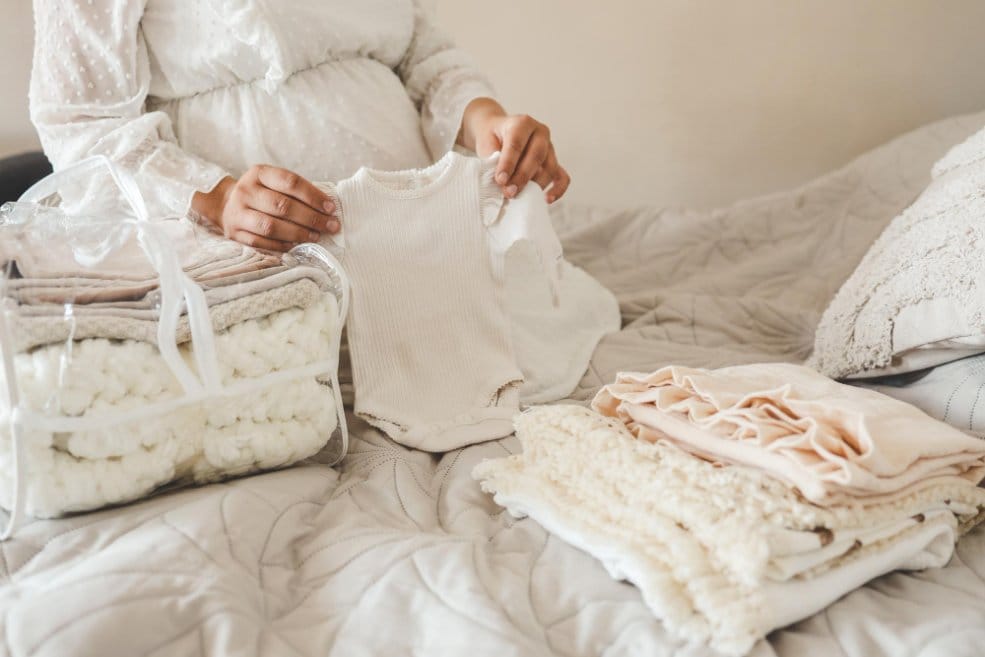
Special Considerations for Organic Fabrics
Organic and sustainable baby clothes require special care to maintain their eco-friendly benefits and prevent excessive shrinkage. Organic cotton often shrinks more than conventional cotton because it undergoes minimal chemical processing.
GOTS-Certified Organic Cotton Care
- Expect 5-8% shrinkage even with careful washing
- Use only cold water (30°C/86°F or below)
- Choose eco-friendly, enzyme-based detergents
- Air dry whenever possible to preserve organic fibers
- Avoid fabric softeners that can damage organic treatments
Bamboo and Tencel Fabric Guidelines
These sustainable materials require gentle handling:
- Wash on delicate cycle only
- Use minimal detergent to preserve natural properties
- Expect 3-6% shrinkage on first wash
- Lay flat to dry for best results
Natural Fabric Softening Methods
Instead of chemical fabric softeners, try:
- White vinegar in rinse cycle (1/4 cup)
- Wool dryer balls for natural softness
- Baking soda added to wash cycle
- Line drying followed by brief fluffing cycle
Smart Sizing and Brand Comparisons

Different brands use their own sizing charts, materials, and fits, which affects how baby clothes shrink or fit after washing. Knowing how these differences play out can help you find clothes that last and fit your baby well.
How Sizing Differs With Brands
Baby clothing sizing is not universal. For example, Carter’s sizing usually matches the baby’s age, but some babies may outgrow them faster, especially if the fabric shrinks. Walmart’s lines of Carter’s clothes tend to be thinner and shrink more easily in the wash, which you have to consider when picking sizes.
| Brand | Typical Fit | Shrinkage Risk | Fabric Quality | Sizing Recommendation |
|---|---|---|---|---|
| Carter’s (Regular) | True to age | Medium-High | Good | Size up for cotton items |
| Carter’s (Walmart) | Runs small | High | Fair | Size up 1-2 sizes |
| Little Planet (Organic) | True to size | Medium | Excellent | Size up 1 size |
| Gerber | Runs small | Medium | Good | Always size up |
| Primary | True to size | Low | Excellent | True to size okay |
| H&M Baby | Runs large | Medium | Fair | True to size |
| Target (Cat & Jack) | True to size | Medium | Good | Size up for longevity |
| Gap Baby | Runs small | Medium | Very Good | Size up 1 size |
How quickly do babies change clothes size?
During the first 6 months, babies typically need new sizes every 6-8 weeks. From 6-12 months, growth slows to every 2-3 months. After age 1, children usually stay in the same size for 4-6 months. Plan your purchases and shrinkage expectations accordingly.
Quality Indicators and Shopping Tips
When shopping for baby clothes, look for these quality indicators that suggest better shrinkage resistance:
- Pre-shrunk labels: Reduces but doesn’t eliminate shrinkage
- Higher thread count: Denser weaves shrink less
- Blended fabrics: Cotton-polyester mixes are more stable
- Quality seams: Double-stitched items handle shrinkage better
- Care label details: Specific instructions indicate better quality
Troubleshooting Common Problems
Even with careful planning, you might encounter shrinkage issues. Here’s how to diagnose and solve common problems:
Severe Unexpected Shrinkage
Possible Causes:
- Water line plumbing error (hot/cold reversed)
- Washer malfunction
- Mislabeled fabric content
- Defective pre-shrinking process
Solutions: Check water temperature, test washer settings, contact manufacturer
Uneven Shrinkage
Causes: Overloading washer, twisted clothes, poor water circulation
Prevention: Wash smaller loads, untangle clothes before washing, use appropriate water level
Clothes Feel Stiff After Washing
Causes: Hard water, too much detergent, over-drying
Solutions: Use water softener, reduce detergent amount, remove clothes while slightly damp
Mold on Baby Clothes
Prevention: Ensure complete drying, improve ventilation, clean washer regularly
Treatment: Re-wash in hot water with enzyme cleaner, dry thoroughly
Persistent Odors
Causes: Incomplete cleaning, bacteria buildup, insufficient drying
Solutions: Pre-treat stains immediately, use enzyme cleaners, ensure thorough drying
Colors Fading
Prevention: Wash in cold water, turn clothes inside out, separate darks and lights
Recovery: Use color-safe bleach alternatives, avoid over-washing
When to Contact Manufacturers
Contact the clothing manufacturer if you experience:
- Shrinkage exceeding 10% on first wash
- Pre-shrunk items that shrink significantly
- Seams that separate due to shrinkage
- Care labels that seem incorrect for the fabric
Many brands offer exchanges or refunds for excessive shrinkage issues.
Special Methods for Minimizing and Reversing Shrinkage
Many parents worry about baby clothes shrinking after washing or drying. Some practical approaches using items like vinegar and hair conditioner can limit shrinkage or even help relax the fibers.
Can you unshrink baby clothes?
Yes, you can often partially unshrink baby clothes, especially if they’re made of natural fibers. The success depends on the fabric type and severity of shrinkage.
Unshrinking Process
Using Vinegar and Hair Conditioner
You can sometimes use white vinegar in the rinse cycle to help soften fabrics and reduce shrinking. Vinegar can loosen fibers, making clothes less likely to get stiff or smaller in the wash.
For clothes that have already shrunk, hair conditioner can help. Fill a basin with lukewarm water and add about a tablespoon of conditioner. Then, soak the garment for 15-30 minutes. The conditioner relaxes the fibers, making the fabric easier to stretch back into shape.
| Method | Best For | Success Rate | Time Required |
|---|---|---|---|
| Hair Conditioner Soak | Cotton, cotton blends | 70-80% | 30 minutes + drying |
| Baby Shampoo Method | Delicate fabrics | 60-70% | 20 minutes + drying |
| Vinegar Rinse | Prevention method | 50-60% | Normal wash cycle |
| Steam Treatment | Wool, natural fibers | 60-75% | 15 minutes + stretching |
How to stretch out baby clothes?
After treating the clothes, lay them flat on a clean towel. Gently pull and smooth out the fabric to return it to its original size and shape. This step works best while the garment is damp, making fibers more flexible.
Step-by-Step Stretching Process
- Soak the shrunken item in conditioner solution for 30 minutes
- Gently squeeze out excess water (don’t wring)
- Lay flat on a clean, dry towel
- Gently stretch the fabric in all directions
- Pin edges to maintain stretched shape while drying
- Allow to air dry completely before removing pins
How long does it take for clothes to unshrink?
The unshrinking process typically takes 30 minutes for treatment plus 4-8 hours for air drying. Results are usually visible immediately after treatment, but the final outcome becomes apparent once the garment is completely dry.
Are shrunken clothes permanent?
Shrinkage isn’t always permanent, especially for natural fibers like cotton. However, synthetic fibers and severely heat-damaged items may not respond to unshrinking treatments. The sooner you treat shrunken clothes, the better your chances of success.
What To Do If Baby Clothes No Longer Fit
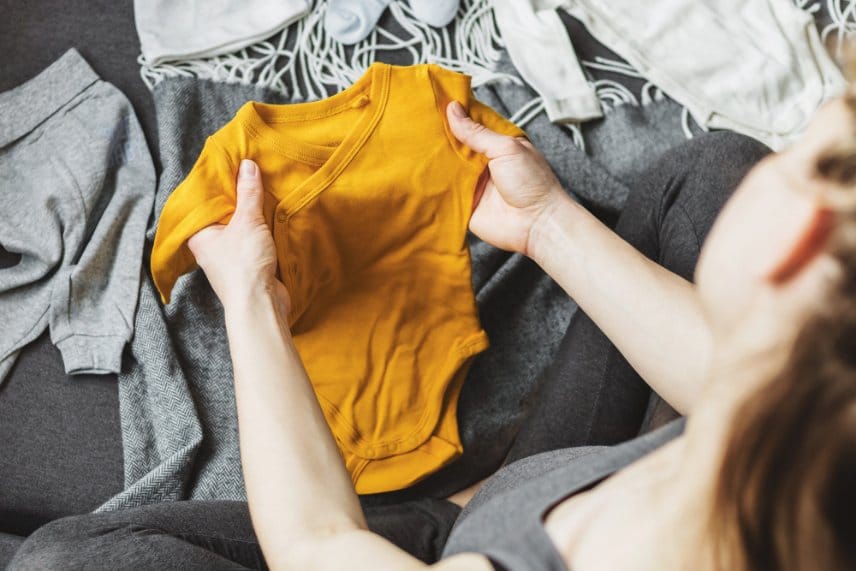
Sometimes, baby clothes shrink in the wash or a baby quickly outgrows them. There are several useful steps you can take when this happens, including making small adjustments at home or finding other ways to use the clothes.
How do I know if my baby’s clothes are too small?
Watch for these signs that indicate clothes have become too tight:
- Red marks: Clothing leaves imprints on baby’s skin
- Difficulty dressing: Struggles getting clothes on/off
- Limited movement: Baby seems restricted in motion
- Riding up: Onesies constantly pull up from diaper area
- Tight necklines: Potential safety hazard around neck area
Are baby clothes supposed to be tight?
No, baby clothes should never be tight. Properly fitting baby clothes should allow for easy movement, comfortable breathing, and room for growth. Tight clothing can restrict circulation, cause discomfort, and pose safety risks.
What happens if a baby wears tight clothes?
Tight clothes can cause several problems for babies:
- Circulation issues: Restricted blood flow to extremities
- Breathing problems: Tight chest area can affect breathing
- Skin irritation: Chafing and red marks
- Development concerns: May restrict natural movement
- Safety risks: Tight necklines can be dangerous
Adjusting Clothing Fit At Home
When baby clothes are a bit too snug, sometimes you can stretch them back out. Do this by gently soaking the clothes in lukewarm water mixed with a little baby shampoo or conditioner. After soaking for about 30 minutes, carefully stretch the fabric while it’s wet, focusing on tight areas like sleeves or the body.
If stretching doesn’t work, you might modify the clothes. For example, you could remove tight elastic bands or snip the seams and hem them after. Small add-ons like an extra snap button or a fabric insert can make things more comfortable for a growing baby.
How to store baby clothes that are too small?
Proper storage helps preserve clothes for future use:
- Clean thoroughly: Wash and completely dry before storing
- Sort by size: Label containers clearly
- Use airtight containers: Prevent moisture and pests
- Add cedar or lavender: Natural moth deterrents
- Store in cool, dry place: Avoid basements or attics
- Check periodically: Ensure no moisture or pest issues
Repurposing or Donating Shrunk Clothes
If a piece of baby clothing is too small after trying to adjust it, look for ways to repurpose it. Shrunk onesies and shirts can be turned into soft rags, burp cloths, or even reusable wipes for household cleaning. Sometimes you can keep special items as keepsakes or use the fabric for crafts like quilts or memory bears.
If the clothes are still in good condition, consider donating them. Local charities, shelters, or family friends may appreciate gently used baby clothes. Before donating, wash all items and check for any stains, damage, or small parts that could be unsafe.
Safety Considerations and Medical Advice
Understanding the safety implications of baby clothing care helps protect your child’s health and comfort.
Special Care for Babies with Eczema
If your baby has eczema or sensitive skin, you need to be extra careful when washing their clothes:
- Choose detergents that are hypoallergenic and fragrance-free
- Double rinse each load to remove all detergent residue
- Use liquid detergents instead of powders (leave fewer residues)
- Wash clothes separately from family laundry
- Avoid fabric softeners and dryer sheets completely
- Test new products on one garment before washing everything
How tight should baby wearing be?
Baby clothes should allow the “two-finger rule” – you should be able to fit two fingers between the clothing and your baby’s body. This ensures:
- Proper circulation
- Comfortable breathing
- Freedom of movement
- Room for normal growth
Flame Retardant Protection
Many children’s pajamas are treated with flame-retardant chemicals. Important considerations:
- Never use fabric softeners on flame-retardant clothing
- Follow care instructions exactly to maintain protection
- Replace pajamas if they become too small (tight fit reduces effectiveness)
- Choose natural fiber alternatives if you prefer chemical-free options
When to Consult Your Pediatrician
Contact your baby’s doctor if you notice:
- Persistent skin irritation after changing detergents
- Red marks that don’t fade quickly after removing clothes
- Signs of restricted breathing due to tight clothing
- Unusual reactions to specific fabrics or treatments
Frequently Asked Questions
A tumble dryer isn’t essential but can be very helpful, especially during winter or in humid climates. If you use one, stick to low heat settings to prevent shrinkage. Air drying is always the safest option for preventing shrinkage, but dryers save time when you’re dealing with frequent outfit changes.
Yes, most baby clothes can go in the tumble dryer, but use low heat settings only. Always check care labels first. Items with appliques, elastic, or special treatments may need air drying. Remove clothes while slightly damp to prevent over-drying and shrinkage.
Yes, always wash baby muslins before first use. New muslins may have manufacturing residues and can shrink significantly on first wash. Pre-washing removes chemicals and prevents unexpected shrinkage when you need them most.
Not all clothes shrink equally. Natural fibers (cotton, wool, linen) shrink more than synthetic fibers (polyester, nylon). Pre-shrunk items shrink less but may still have some shrinkage. Blended fabrics typically shrink less than 100% natural fibers.
Use cold water (30°C or below), gentle cycle, and air dry when possible. If using a dryer, choose low heat and remove clothes while slightly damp. Avoid overloading the washer and use appropriate amounts of gentle detergent.
Yes, but use low heat settings only. High heat is the main cause of shrinkage. Remove clothes while slightly damp and let them finish air drying. Always check care labels for specific instructions, as some items require air drying only.
Use the lowest heat setting, don’t overload the dryer, remove clothes while slightly damp, and consider using wool dryer balls instead of dryer sheets. For delicate items, air drying is always the safest option.
Conclusion
Understanding baby clothing shrinkage is essential for new parents who want to make the most of their investment in quality baby clothes. While it’s completely normal for baby clothes to shrink, especially those made from natural fibers like cotton, you can significantly reduce shrinkage through proper care techniques.
The most important factors in preventing shrinkage are temperature control and gentle handling. Cold water washing, low heat drying, and air drying when possible will help maintain your baby’s clothes in their original size. Remember that some shrinkage is inevitable with natural fibers, so sizing up strategically can help accommodate both growth and shrinkage.
Different brands and fabric types behave differently, so understanding these variations helps you make informed purchasing decisions. Quality fabrics and pre-shrunk items offer better shrinkage resistance, though they may come at a higher initial cost.
Key Takeaways and Recommendations
Essential Care Practices:
- Always wash new baby clothes before first use
- Use cold water (30°C/86°F or below) for most items
- Choose low heat or air drying to prevent shrinkage
- Read and follow care labels carefully
- Size up for cotton items to accommodate shrinkage
Smart Shopping Strategies:
- Look for pre-shrunk labels when possible
- Consider cotton-polyester blends for less shrinkage
- Research brand-specific sizing before purchasing
- Buy slightly larger sizes to accommodate growth and shrinkage
- Invest in quality items for frequently worn pieces
Seasonal Considerations:
- Plan drying strategies for your climate
- Use dehumidifiers in humid conditions
- Take advantage of natural sun drying when possible
- Ensure proper ventilation for indoor drying
🎯 Take Action with Our Expert Tools
Get personalized guidance for your baby’s clothing care:
📊 Calculate Expected Shrinkage – Predict fabric shrinkage based on type and care method
📅 Seasonal Care Calendar – Month-by-month care guidance for optimal results
Safety First:
- Never compromise on proper fit for safety
- Follow American Academy of Pediatrics guidelines for clothing safety
- Ensure flame-retardant properties are maintained per CPSC regulations
- Choose age-appropriate clothing that meets safety standards
- Consult your pediatrician for babies with sensitive skin or eczema
Remember, while preventing shrinkage is important for your budget and convenience, your baby’s safety and comfort should always come first. When in doubt, size up rather than risk clothes that are too tight. With proper care techniques and smart shopping strategies, you can maintain your baby’s wardrobe while keeping them safe, comfortable, and stylish.
For additional guidance on fabric care and baby clothing, consult resources from the American Academy of Pediatrics and always follow manufacturer care instructions for the best results.

